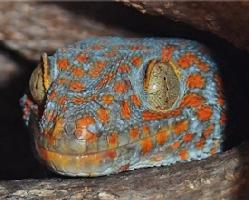
Weights and measures
| Length | from 20 to 30 cm |
|---|
Biological data
| Lifespan | 20 r |
|---|
Animal description
The Leopard Gecko, scientifically known as Eublepharis macularius, is a captivating and widely popular reptile in the pet industry, cherished for its distinctive appearance and docile nature. Originating from the arid and semi-arid regions of South Asia, including parts of India, Pakistan, Afghanistan, and Iran, this nocturnal creature thrives in rocky, dry grassland and desert environments. The species is known for its remarkable adaptability and resilience, characteristics that have contributed to its success both in the wild and in captivity.Characterized by its robust body, the Leopard Gecko typically measures between 8 to 10 inches in length when fully grown, with females generally being slightly smaller than males. Its skin is velvety to the touch and is adorned with a unique pattern of spots and bands, reminiscent of the big cat it is named after. The coloration of Leopard Geckos can vary widely, from the natural yellow and black wild-type to an array of designer morphs in shades of orange, pink, lavender, and even patternless varieties, developed through selective breeding.
One of the most striking features of the Leopard Gecko is its large, expressive eyes, which are equipped with eyelids—a rarity among geckos. This adaptation allows them to blink and close their eyes while sleeping, offering protection from dust and debris in their arid habitats. Another distinctive characteristic is their tail, which is thick and fleshy, serving as a storage site for fat reserves that the gecko can draw upon when food is scarce. In a remarkable display of self-preservation, Leopard Geckos can detach their tails when threatened, a process known as autotomy, allowing them to escape predators. The tail will eventually regenerate, though it may not match the original in appearance.
Leopard Geckos are ectothermic, relying on external sources of heat to regulate their body temperature. In their natural habitat, they utilize the warmth of the sun-soaked rocks and sand during the night. In captivity, this is mimicked through the use of under-tank heaters and basking lamps. They are primarily insectivorous, feasting on a diet of crickets, mealworms, and other small invertebrates. Captive Leopard Geckos also benefit from a calcium and vitamin supplement to ensure their nutritional needs are met.
Reproduction in Leopard Geckos is relatively straightforward, with the breeding season typically commencing in the spring. Females can lay multiple clutches of eggs during the breeding season, with each clutch containing one to two eggs. These eggs require a warm, humid environment to incubate, with the temperature playing a crucial role in determining the sex of the hatchlings—a phenomenon known as temperature-dependent sex determination.
Leopard Geckos have a gentle temperament, making them excellent pets for reptile enthusiasts of all levels, including beginners. They are known to exhibit a range of behaviors and vocalizations, including chirps and squeaks, which can be indicative of their mood or needs. With proper care, these fascinating creatures can live up to 20 years in captivity, making them a long-term commitment for any pet owner.
Their ease of care, combined with their captivating appearance and engaging personalities, has solidified the Leopard Gecko's status as one of the most beloved reptiles in the pet trade. For those considering a Leopard Gecko as a pet, it is crucial to research and understand their specific care requirements to ensure a healthy and happy life for these remarkable creatures.
Similar Animals
New photos of animals
Top 10 animals
- Dolphin gull (Leucophaeus scoresbii)
- Diana monkey (Cercopithecus diana)
- Moustached guenon (Cercopithecus cephus)
- Galápagos tortoise (Geochelone nigra complex)
- Japanese macaque (Macaca fuscata)
- Stone loach (Barbatula barbatula)
- Russian tortoise (Testudo horsfieldii)
- Greek tortoise (Testudo graeca)
- Common flying dragon (Draco volans)
- Vendace (Coregonus albula)


